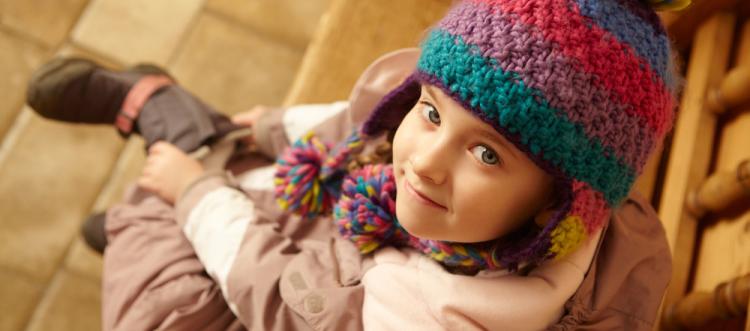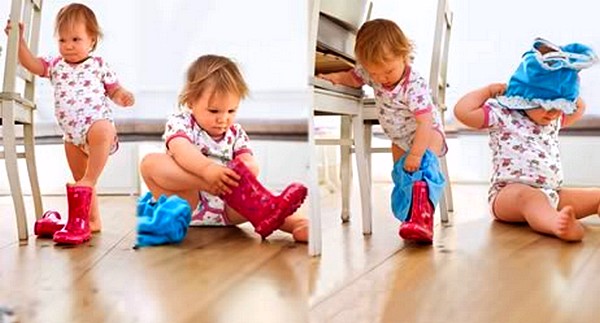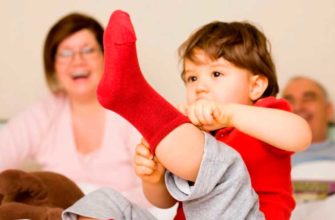The expressed desire of babies to do something on their own usually manifests itself when they reach the age of two. This is the best time for children to start learning how to dress on their own without the help of their mother. Try to take advantage of the features of this period, then you will not have to suffer subsequently from the fact that your child is "not adapted" to life.

Dressing independently is necessary to master especially for those children who are preparing to go to kindergarten. There will be many children in the group, and the teacher will not be able to devote much time to your baby. And he himself will be much more comfortable and convenient if he manages to do without anyone else's participation, when he will need to change clothes / undress / get dressed for a walk.
Developing the desire for independence
To start teaching a child self-dressing skills should be from two to three years. From about this age, the child has a persistent desire for independence and if you react in time and correctly, then you don’t have to force the child to do something on his own - he himself will strive for it. Therefore, if your baby is now exactly at this age (from two to three years), pay attention to a few recommendations.
Not all at once for kids it turns out as their parents would like. There are times when it is very difficult for mom and dad to restrain their anger or irritation, watching their child put on slippers on the contrary or button buttons incorrectly. This is a very serious test for the nerves of adults, to whom children's "oversights" seem like a real provocation. “Well, how do you not understand that this slipper is on your left foot? Left, do you hear? Where have you put it? ” or “Look what are you doing? Better me myself! ” - Mom does not hold back.
This behavior is not permissible for parents. Remember, not so long ago a child was not even able to walk, for him his every action is overcoming obstacles: his fingers absolutely do not want to “obey” and become agile, and it is not possible at all to distinguish the right slipper from the left. Adults cannot put themselves in the place of little men who are just starting to live, because they do not remember themselves at this age. It’s very easy to discourage babies from showing off, but you can only help them with this, having a large supply of patience, endurance and love.
If you notice that your child is trying to pull on a shirt or take off his tights, be sure to "note" this: “What a fellow you are! You are doing so well! ” or "I see, you have already grown (grown)!". You will see what joy flares up in the eyes of the little crumbs from your words, and he will try to repeat his attempts to dress more and more often. You can correct, if necessary, the same shirt or “hold” the tights so that they do not get stuck in some parts of the leg, but you must do this discreetly, emphasizing the actions of the child himself.
Memo to parents:
- Never make fun of a baby.
- Do not criticize his actions.
- Do not rush him.
- Do not focus on failures.
- Give praise more often (even if his act seems insignificant to you).
- Help him.
When and where to start
Surely, you noticed that your kid, returning from another walk, is already trying to take off his hat and pull off his shoes, and does it with more dexterity than he dresses. This behavior is due to the fact that children always like to undress more, freeing their body from a lot of things. Hence the desire to undress independently, thanks to which the first skill of handling their clothes is formed.

After the child has learned to take off some things, he will now try to put them on. Take, for example, the situation when the baby goes to the potty. To take off his pants for him is no longer a problem, but a familiar occupation. But putting them back on is not always easy. Do not rush to do it instead of him, the baby should try his hand himself. If you stand aside and watch him, you will see that your child is already pulling his panties back, and it turns out he is not at all as bad as you thought. Do not forget to praise him, this will push your little one to new “exploits”.
READ ALSO: How to teach a child to wipe his ass
Soon you will see how the baby puts on a hat or tries to get into the jacket. Let it be a little inept, only his desire matters here. Be sure to emphasize its independence with laudatory words, demonstrate your pleasant surprise.
You can learn how to fasten and unfasten Velcro at the age of one and a half years, when the child begins to show interest in shoes and clothes. His fingers are already strong enough to handle Velcro. In the same period, you can teach to untie the ties on the hat.
Closer to two years You can go to the buttons on the jacket, shirt, blouse. Before a year and a half, it is undesirable to teach the baby to unfasten and fasten buttons, since the wrist joint (the joint between the bones of the wrist and forearm) and the coordination of hand movements are not sufficiently developed for this kind of manipulation. In addition, button fastening to a one-year-old baby may not be possible.
After two years you can already get acquainted with lightning. A slider can be moved up and down by a child who is not yet two years old. It is more difficult to teach the kid to independently insert the lock into the opening. This work is more subtle and requires sufficient coordination of finger movements and understanding of the final result.
At the age of 2-2.5 years you can teach the baby to fasten buttons. A developed thumb, a confident grip at this age will help to consolidate the skill. For the baby, it’s not just copying that is important: he put the button in the buttonhole — she fastened it, pulled it out — unfastened it — awareness of her actions is necessary.
What difficulties can a child have in dressing?
- the child gets confused in the sequence of dressing (for example, he will put on trousers first, and only then will remember that the trousers are put on tights);
- complexity of fastening (laces, tight buttons, complex fasteners on clothes);
- the difficulty of determining where the front and where the back of the clothes (if it is panties, trousers, then the child often puts them on the contrary, you have to change clothes again);
- the kid confuses pair things, for example, puts on shoes on the contrary: the right shoe on the left foot, and the left shoe on the right;
- the child puts both legs in one trouser leg or puts them on backwards;
- clothes unpleasant for the baby (too tight collar of the T-shirt in which the head is stuck; prickly blouse, too tight tight jacket);
- the difficulty of determining the front and back side of clothing. The kid can put on a blouse "overturn", that is, with the seams out.
As we can see, dressing familiar to all of us is not an easy process for a child. He develops both thinking, and speech, and fine motor skills, and sensorimotor coordination. And the baby in mastering this process needs help and support from adults.
Learn to dress
Sometimes quite funny moments occur when the baby tries to dress himself. He can come to you in a jacket worn backwards or with two legs in one leg. It’s hard to hold back a laugh while seeing all this. But try to hide such your reaction, the baby may be offended or worse, will specially dress incorrectly to make you laugh. Then you have to fix your mistake for a long time.
Therefore, you need to constantly describe the baby the whole sequence of your actions when you dress him. “We take a blouse, look where we have a dog drawn. The dog should be in front. We put our head in the neck and see if our dog is in place. Everything is in order, she is in place. Now we stick one handle into this sleeve, and the second into this one. We have succeeded. You and I are well done! ” or “Shorts should be worn so that the lock is under the dog. Poke one leg here, and the second? Right, there! You're just smart. ”. After such comments, the baby will remember what to be guided by and in what order things should be worn.
Explain to the child what signs he should use when dressing. Drawing, zipper, pockets and buttons will become for him a kind of compass that will show the right direction. For these purposes, buy clothes with a pronounced front side and visible seams, with a colorful large pattern on the front of the clothes.
Next, begin to “master” more complex wardrobe items - tights, knee-high socks and socks. Try to buy loose items from soft stretching fabrics. Take a pair of slightly larger socks and tights. It is easier for kids to wear wide and spacious things than to pull tight and uncomfortable tights on their legs. If the baby cannot cope with this on his own, help him, show him how to do it right.
Often, the design of clothing itself prevents the child from learning to dress independently. All kinds of newfangled "bells and whistles", such as trompe l'oeil, numerous zippers sewn out of place buttons and laces, only complicate the baby's life. For this reason, at first it is preferable to buy clothes with large buttons, fasteners, as well as items with Velcro or elastic bands. Wardrobe items “equipped” with such things are very convenient to use.
Stubborn age
By the age of three, a child enters a period of negativity and stubbornness, so it is better to teach him how to dress and dress earlier than later. If you want to teach him to fasten buttons, do not put off until three to four years. The kid will get used to the fact that he is dressed, and the desire to do everything on the contrary does not contribute to the formation of the skill. In the “stubborn” age, the baby does not enjoy the approval, becomes masterful, so it’s quite difficult to teach him how to dress independently.
![]() How to wear shoes? Velcro & Sashes
How to wear shoes? Velcro & Sashes
Velcro shoes are the best way to start training. Give your baby the shoes, show how it closes and unfastens; he will like the sound of Velcro. Let him repeat your actions: even one and a half year old crumbs can do it. Praise the child, if he succeeded in buttoning his shoes, rejoice in his achievements.
Make sure that he now shoes (fastens Velcro) independently, without outside help. If Velcro is on the baby’s clothes, he himself can guess what they are for.
Then we untie the hat: with one hand we take the tie, pull it down and the hat can be removed. Make sure that the baby tugs at the tip, not at the bow, otherwise the knot will be tightened, and the baby will not be able to take off his hat.
![]() Buttons
Buttons
Slowly show how you fasten the buttons on the jacket. Let the baby hold the base of the button with the fingers of one hand, and with the other hand put the second half of the jacket on top. Clicked! Holding the buttons of the button with both hands and pulling the floors in different directions, you can unfasten the clothes. Such a discovery will delight and interest the child.
Explain to the baby that if he pulls the jacket floors with force, the buttons will come off and the clothes will be spoiled.
![]() Lightning
Lightning
The zipper on the pockets is fastened and unfastened if you pull the lock up or down, right or left. Without lengthy explanations (in 1.5 years, a few clear, short phrases are enough) show the baby how to handle the zipper. When going for a walk, let the baby do it himself.
To start training, use zippers with a large clasp and lock. Let the child notice that there is a hole in the lock. First, we lower the slider down, insert the base of the second side of the zipper into the hole, and only after that pull the lock up. First, insert the slider into the hole yourself, offering the child to fasten and unzip, then let the baby try.
![]() How to fasten buttons?
How to fasten buttons?
Children's clothing is not only with Velcro, zippers, but also buttons. Button closure training can be turned into an interesting game. Sew a few large buttons onto a piece of fabric, and loop through another cloth. Kids enjoy playing and at the same time training in a useful skill. By the way, for the development of fine motor skills, use all that is at hand: wash buttons and Velcro on soft toys and some household items. So, the ears of a hare can be made clinging to the head - fasten them on buttons, and fasten the blinds in the nursery with Velcro.
In the formation of the skill, use a keen desire to imitate. Demonstrate to your child how you can fasten your blouse or sweater (preferably with large round buttons). Slowly show how you buttoned the button. Let the baby take the button with one hand and push it into the loop (you need to start with the lower buttons, as this is more convenient). It can be difficult for a child to catch a button in a buttonhole, as small handles are not yet dexterous. However, constant training will contribute to the formation of the skill, and the baby will surely succeed. Invite your child to fasten his blouse yourself or ask for help to fasten the buttons on your clothes. At the same time, do not forget to say that you are growing a real assistant (assistant); children like it, they begin to be proud of themselves and their achievements.
When the baby understands how the buttons are fastened, he can himself be curious and try to push the button back. If this did not happen, show the baby how to unfasten them, and in time he will master this process perfectly. Do not forget to help the child cope with the upper buttons, as fastening what you cannot see is quite difficult to touch at that age.
![]() How to wear panties?
How to wear panties?
Explain to the child that it is more convenient to wear trousers while sitting on the bed, stretching your legs in front of you, and you can get up after the feet emerged from under the trouser legs. Do not forget to praise the child even for his small successes.
![]() How to wear a t-shirt?
How to wear a t-shirt?
In order for a child to learn how to deal with a sweater, t-shirt, things must be free, with a minimum number of buttons, buttons. It is important that the neck is free and the clothes pass freely through the head. Otherwise, the child will not only not cope with the uncomfortable thing, but will begin to get angry, and then completely refuse to dress.
Try to calmly and without irritation explain to the child that the neck of the sweatshirt must be climbed into the top of the head, and not by a person who may be stuck in the neck.You will have to repeat this not once, but many many times, have patience.
![]() Tie the shoelaces
Tie the shoelaces
Show your baby how to tie shoelaces. To get started, practice knitting simple knots: let the little one pick up both ends of the lace, put them on top of each other crosswise and thread one end under the other (“in the hole”), then pull the ends of the lace in different directions. The knot turned out!
When the baby learns to confidently knit knots, you can master the bow. To make the crumbs easier, at the beginning of the training we ourselves fold the ends of the shoelaces in half (in a bow), giving them into the hands of the child. Kroha can only tie another knot. Closer to 4.5 years, you can already ask your child to fold the ends of the lace into a bow with your own hands and tie the laces yourself.
You need to train constantly, since the baby can master any skill only in frequent exercises. Use the child’s interest in new items, in games and toys: tie bows to dolls and to each other, make knots on your mother’s belt or on a beautiful satin ribbon, use various lacing games, play pirates and knit “sea knots” on a rope. All this will help to form a skill, and you yourself will not notice how your child starts to lace up his shoes.
You may have to rethink his wardrobe to teach your child how to dress himself. It is possible that some things should be abandoned for a while. And before buying new clothes, mentally imagine if a child can put on a new thing himself.
Do not suppress a child’s initiative. If he wants to try to dress himself - do not bother him. But do not immediately require the child to dress only himself. Very often, parents simply can not stand the slow pace of dressing the baby and, feeling that they are already late, they begin to rush to dress the child in a hurry, preventing them from getting dressed on their own. In this case, it makes sense to start the training a little in advance, taking into account the time for a quiet development of the skills of dressing the baby.
Choose clothes
- When buying clothes, mom should pay attention to the features of such details as Velcro, laces, buttons, buttons and zippers. Sometimes a child’s success directly depends on how convenient it is to use these details;
- Velcro on shoes and clothes should be wide, with good fasteners. If the special tape sticks badly, the baby will begin to get nervous, thinking that he does not succeed, and then lose interest in such an important matter;
- The buttons should snap into place easily and snap open easily. New buttons are often tight, so you need to develop them first;
- Buttons must be round. Buttons with pointed and uneven ends, resembling flowers or figures of various animals, are very beautiful, but it’s hard to fasten them at times even for an adult. The button should pass freely into the loop. Its size should be such that the baby can easily take it with two fingers. It will be difficult for the child to grab too small buttons;
- The zipper should also be easily fastened and unfastened without jamming. Make sure that the castle is large: small and thin usually does not lend itself to the baby’s fingers, making it difficult to form a skill;
- Choose laces with sturdy ends, plastic or metal. Let the ends of the shoelaces be not too long and not too short: exactly so that the child could tie a knot and a bow without additional effort.
Parent Tips
- Divide all things into two groups: the baby puts on one, the mother puts the second on the child. For example, mom puts on tights and a turtleneck, and the baby - trousers, a vest and a hat. Accustom the baby to the sequence, give him things in turn. First, mom puts on tights, then a turtleneck. After that, she gives the child a pair of pants. When trousers are dressed - a vest, then - a hat. You can also put these things on the bed in the correct order so that the baby knows what to wear. You can also make a "cheat sheet" and hang it in a conspicuous place in the room.Draw on a piece of paper a child (girl or boy, depending on who you have). Then, from the image of the child, draw an arrow to the image of the thing that you need to wear first. Then from this thing to the next and so on. Such a scheme will allow the child to better remember the order of dressing;

- Prepare your clothes in advance. If you are going to go for a walk in the morning, it is better to cook things in the evening, especially in the winter season. Lay them out in a specific order on a chair or on a bed;
- Buy items with colorful prints, appliqués, or embroidery on the front of your clothes. This will allow the baby to quickly identify the front and front of the clothes;
- Do not take clothing made of thick material. (unless it is outerwear), give your preference to natural soft fabrics. A comfortable neck, loose sleeves, pants with elastic bands or Velcro - this is what you need to pay attention to when choosing a child's clothes;
- Turn the dressing process into a pleasant activity, coupled with a good mood and a fun game. As soon as the baby feels that this occupation is becoming something ordinary, he will immediately lose interest. Therefore, at the moment when the baby is getting dressed, you can hum your favorite song or say a count;
- Give freedom to choose things. If the baby categorically refuses to wear this or that thing, there is no need to insist. “Do you want to go in a green T-shirt? Let's choose another one! ” or “Do you want to wear this blouse because it does not fit your current mood? Perhaps then this one with a beautiful boat will do? ”. It is important for children to know that their opinion is important to you, and you reckon with it. Most likely, the problem will be solved very quickly;
- When choosing a wardrobe, consider the taste of your crumbs. Invite him to choose an outfit for himself. If his choice doesn’t seem entirely successful, praise him anyway. Just add that some things do not really fit together or do not match the weather on the street. You can say: “What a great taste you have! You are a real mod. But if we change these pants to another, brown, your outfit will be just great! ” or “Great choice!” And how did you manage to pick up such a kit? Only in this blouse you will be cold today, you saw how cold it is on the street ". The main thing is to explain the reason to the child - it is too cold, hot, not due to weather or the colors do not mix well;
- Do not force to dress yourself. If the child for some reason does not want to wear things himself, do not get angry. Perhaps he feels bad or just woke up in a bad mood. Encourage him, say that there is nothing wrong with that. Ask him only to help you - you have already "lost the habit" of doing this: “I completely forgot how to wear socks, maybe you can tell me?” or “The blouse is offended that you don’t want to wear it. She thinks you don't like her. ”. Believe me, kids react very quickly to such statements;
- Allow more time for the baby to dress. Many parents, when in a hurry somewhere, get annoyed by the slowness of the child and begin to push him. And sometimes they even tear clothes out of the hands of the baby and, with nervous movements, start dressing the baby themselves. Firstly, such behavior will only create tension in the family, and secondly, the little baby will have a feeling of helplessness. Therefore, devote three times more time to dressing the baby yourself than it takes you.
What to do if the baby does not want to dress himself
If the baby does not show a clear desire to dress independently, try starting with simple manipulations with his things. Do not put on clothing until the end, for example, tights to the knees or just one boot. Invite the baby to complete your action, ask: “Do you know what to do next?” or “Something is wrong here. ... It seems that today I got up on the wrong foot and am confusing everything. Will you help me? ”.
You can also endow things with magical properties, think of how they feel when they are put on. Tell me that all the T-shirts from your baby’s wardrobe flew in from the country of T-shirts especially for him to wear them: “They were arguing among themselves so much who would fly to you first, that they almost fought”. Try to talk with the child in a squeaky childish voice of a T-shirt or blouse, voice their desires: "Choose me! I so want to take a walk today with you! ” or “You didn’t want to take me with you yesterday. I hope you’ll even put me on today? ”. No matter how stupid such an idea may seem to you, believe me, it will cause delight in the baby, even if he understands that you are talking instead of things. Later, the child himself will begin to voice the thoughts of his things. This will develop his imagination and give more charm and fabulousness to the world around him.
If the child still stubbornly, then you should play with him in one very interesting game. When you put on trousers or a blouse with sleeves, say that the legs or sleeves are large narrow tunnels, and the legs or arms are trains that have to go this difficult path. It will be interesting for the kid to imagine how “trains enter the tunnel”. And you can characterize the baby's things, like fairy-tale characters. For example, let his blouse be not a blouse at all, but Pinocchio’s jacket, and his cap - a cap, boots - wonderful shoes. There are many options for embodiment, but it is better to choose the character that your baby likes. Perhaps it will be Puss in Boots?
We invent, play, have fun
There is no doubt that the learning process is not always easy. Parents usually need a lot of patience and time. But all difficulties will be easily circumvented if you come to the rescue with a little imagination and a game.
- When your child turns one year old, you can take a large, lightweight box that’s easy to use and put a few things there. At first, your baby will begin to pull them out of there, and later - to try on;
- Develop fine motor skills of the hands. You can do this by sewing on one piece of fabric velcro, zippers, locks, hooks, buttons and bright buttons. Sew button loops, the bottom of the velcro or fasteners on the second flap. Having a little practice, the baby will be able to put his skills into practice;
- Come up with a plot when you are going to go to the playground. Just to go is boring. But if you imagine that this is not a playground, but a spaceship, fees will go much faster. The "astronaut" needs to get dressed in time, otherwise the ship will not wait and fly away without it. If the "astronaut" managed to arrive at the take-off place ahead of schedule, a small prize should be waiting for him. You can navigate by the timer or by the usual alarm clock, pre-set at the right time;
- Arrange a competition, who dresses faster - mom or baby? Mom, of course, must pretend that she is in a hurry and will definitely want to win, but all the time she can stop and figure out how this sock or sleeve of the sweater “interferes” with her all the time. Remember, the baby should win, not the mother. Later, the task can be complicated by discussing in advance that you need to not only fully dress, but also have a neat appearance.
READ ALSO: What a child should be able to do in front of a kindergarten - 4 useful skills
When should positive results be expected?
Self-service skills are formed gradually. Do not try to get ahead of nature, do not focus on other children. Remember that your baby develops individually, so you can’t take for dogma the statement that a child should fasten Velcro in a year and a half, buttons in two, and tie shoelaces in three. If you are sincerely interested in the success of the baby, help in time, show him new, more complex actions, then the child will be happy to dress and shoe on his own.
As a rule, children are able to dress completely independently no earlier than five years.By this age, they can already cope with the biggest difficulties - lightning and laces. To speed up the process, it is necessary to pay constant attention to the development of fine motor skills of the child and, of course, exercise every day. Children learn very quickly and always strive to show that they are adults. Therefore, with the right approach of parents, training in self-dressing does not cause any problems.
READ ALSO:
Mom's tricks: teach a child to dress independently
7 ways to dress a child without whims
How a child can learn to quickly put on a jacket 🙂
Mom to mom: how to have fun and quickly dress for a walk
Key points
- Fold home clothes in a place accessible to the child. At first, the baby will simply pull it out, wrap it up, hide in a pile of things. But by about one and a half years, he, following the example of his parents, will begin to put on hats, socks. And then other clothes.
- If the child is trying to put on something himself (not even very well), fight with your own impatience. Do not help him until he asks.
- Often the first things a baby puts on are dad's t-shirt or mother's socks. First of all, putting on these things is easier, and secondly, more interesting. And thirdly, in them the child satisfies his need to be like parents. Therefore, do not prohibit such experiments, for sure you have clothes that can be donated for games.
- Buy comfortable things for your child - Velcro shoes, sweaters with a wide collar and without fasteners, loose socks and panties.
- Come up with clever ways and games for dressing, interest them in a child. Here's an interesting way to put on a jacket. In Bill Adler’s book “Outsmarting the Baby,” I found advice that allowed my three-year-old son to learn how to put on jackets, sweaters, and shirts in a few minutes. Put the children's jacket on a flat surface (sofa, stool, floor), straighten the sleeves; the unzipped zipper should be on top. Place your child facing the collar or hood of the jacket. The clothes lie as if upside down in relation to the child. Ask the baby to bend to the jacket and put his hands in the sleeves. While the child is in this position, grasp the bottom edge of the jacket and quickly throw it over the baby’s head. Such help is needed only at the beginning. then the child will “dive” under the edge of the jacket while pulling on the sleeves.
- If the child has dressed himself, do not criticize him and, if possible, do not change clothes (even if all things are worn backwards and inside out). On the contrary, be sure to praise the baby. And older children put tags on clothes and shoes so that there are fewer errors.
- Start dressing up and up to two years old to take advantage of the “Myself” period.
- Do not forget that the game, intellectual development and the acquisition of new skills are inextricably linked processes. Make sure that the baby has the right toys that will help him quickly master the art of dressing. First of all, these are, of course, dolls with their doll clothes. In addition, all kinds of developmental aids-games-lacing and all that can be fastened and unfastened (fabric panels, rag books, soft toys with pockets and flaps on which buttons, zippers, Velcro, ties) are very useful. But if the child does not want to deal with such a toy - do not worry. Just develop its fine motor skills in other ways. And the time will come when the child, without any training, learn to fasten the buttons and connect the halves of the zipper.
- When you dress a child yourself, try to draw his attention to the process. Speak all your actions, ask them to hold on to some thing or to perform a simple action on their own.
- Even if it seems to you that the child already knows how to dress himself, do not deprive him of support and attention. Tell me what to wear (for many children this is a difficult task), arrange clothes in order. You can dress at the same time with the child, offering him competition.
- Plan your time in such a way that you can feel relaxed while mastering the difficult science of dressing with your baby.It is better to get up in the morning half an hour earlier than to deprive the child of the opportunity to learn new skills in time.
- Invite him to take off the clothes that are really easy to take off.
- You can hang a poster in the children's picture with the image of different wardrobe items in the sequence in which they need to be worn. It’s very good if you make this poster together with the baby: you will find suitable pictures in magazines (at the same time it will be a good training of memory and attention for the baby - there are so many new names to remember), cut and paste them on a piece of paper.
Sources: http://www.resobr.ru/, http://mam2mam.ru/, http://friends-forum.com/forum/showthread.php?t=101137









Undressing yourself is truly the first expression of freedom. But in our country it is brought to the point of absurdity: my son does not let anyone in until he does everything himself. Difficulties arise with dressing: it is absolutely impossible to fix something - we can walk along the street. Such is Che Guevara growing.
We have an acute problem of dressing appeared in the kindergarten. When all the kids have already mastered this process, and my son is not there yet. Then I went to the trick and we began to learn toys to dress. He loves cats very much. Here we started with cats, he taught them how to wear and studied himself. And after a very short time, it became easier to dress himself.
At two years old, the daughter is already showing her desire to dress herself. Starts with panties, then tights. Sweatshirts and T-shirts so far only takes off. I constantly praise her, although she can often put her inside out or back to front. But, I think, the main thing is not to discourage the child’s interest in independence. Let her dress incorrectly, but herself.